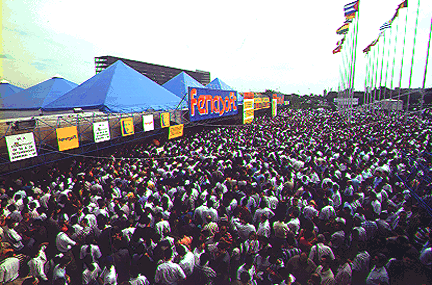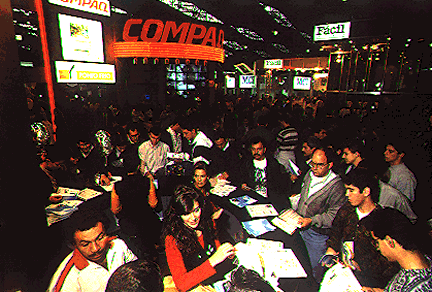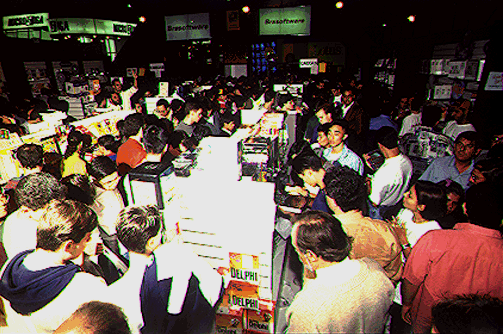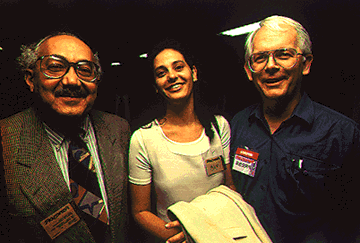|
|
|
|
A week at the largest computer trade show in the world gives the author a view of Brazil's newly booming high-tech market. The cause: radical surgery on import tariffs and an end to 20 years of hyperinflation. The result: explosive growth, an exporter's dream, and a thriving local industry. The market: bigger than the rest of Latin America combined. We sketch this abruptly booming computer market and, in the sidebar "Unix in Brazil," its Unix segment.
|
Mail this article to a friend |
And swarm they do, roughly 150,000 Paulistas, as residents of the most prosperous state in Brazil call themselves, and thousands of others from around the world, each paying the equivalent of $33 to walk, gawk -- and buy, buy, buy.
It's the ninth annual Fenasoft show, and if you imagined Las Vegas Comdex and New York's PC Expo combined and then doubled, you'd start to get a handle on this, the largest computer trade show in the world. Unlike Comdex, it's not the same 150,000 industry insiders coming back each day of the week-long show. Instead, each day a fresh new crowd forms up in a mob scene outside the main doors, for a total this year claimed to be 804,223 paid attendees.

Only a few years ago, Fenasoft was a small show with little to suggest its febrile future. Started as a conference in Rio de Janeiro by one Maximiano Augusto Goncalves, vendor booths were at first permitted at no cost. The booths quickly came to dominate the show, which was moved to Sao Paolo as it grew. But it was still modest in size, because the computer industry in Brazil was strangled by the kind of archtypical high-tech industrial policy beloved of third-world ruling classes.
|
|
|
|
|
Brazil was essentially a closed market, with foreign investment discouraged, most components and finished goods imports restricted, and the rest subjected to severe tariffs and the whims of corrupt customs officials. The idea was to hothouse a native Brazilian computer industry, but this plan worked here no better than it has anywhere else. Add to that inflation that hit 30% per month off and on for 20 years, and Fenasoft showed every sign of remaining a small, regional show, and Max Goncalves a small-time show operator.
But three years ago a reform government took a meat axe to the entire structure of tariff and import restrictions. It killed off most tariffs on imported computer goods, put the rest on strict diets, and allowed foreign companies to set up businesses in Brazil. And, equally important, they finally found a formula for strangling high inflation -- for the first time in living memory.
Last year the Fenasoft show boomed as Brazilians flocked to see the newly legal foreign computers and software. Because of decades of trade restrictions, most Brazilian companies have 8088-based IBM XT-level desktop computers or dumb terminals -- if they have anything at all. Old minicomputers, old host-based Unix systems, and even older mainframes were the order of the day. At Fenasoft, which is a selling show, they were suddenly able to buy (still at pretty stiff prices) computer systems two or three generations newer than anything they had seen before.

This year Brazilians seem like people who have been holding their breath for a year. Inflation, which had abruptly dropped more than an order of magnitude last year to an annualized rate of roughly 30 percent, has been held in check for 13 months -- Brazilians, accustomed to elaborate charts published in the daily papers to calculate today's value of their money, are reeling at the realization that Reals held today will be worth roughly the same next week. They showed up at this year's Fenasoft to discover another phenomenon that we in the U.S. almost take for granted: In the computer business, prices go down, not up. Systems and software are cheaper than they've ever been -- show prices we saw were typically no more than ten to twenty percent higher than street prices in the United States -- and are dropping.
Fenasoft's overwhelming size has at least two sources. One is that Sao Paolo has 22 million people in the metropolitan area, 32 million in the state, and as the industrial capital of Brazil, accounts for the majority of the economic activity in a country the size of the continental United States. Brazil is a third-world country, but not much of that was visible to the Fenasoft visitor. As one local observer pointed out, using the broadest figures, of Brazil's 150 million people, a hundred million are poor, most desperately so. But that still leaves 50 million who are at least middle class -- and that's a third more people than live in California, representing an economy larger than France's. That's how it's possible to find 800,000 to pay $33 each to attend a computer trade show.
The second source of Fenasoft's vitality is the poorly developed retail distribution system in Brazil. The booming economy is still too new, too raw; there's no equivalent of CompUSA, Fry's, or mail-order computer makers to sell discount systems. For most Paulistas, especially small to medium-sized businesses, Fenasoft represents their best opportunity all year to buy discounted computers and software. So they jam themselves in from 2 to 10 pm each day and march out loaded down with bags of software and boxes of systems, looking from the balcony like a mob of army ants dismantling the show.

The Journal of Commerce of New York claimed three billion dollars worth of business was done at the show, an implausible figure even counting all the longer-term deals being cut, but serious money was indeed changing hands. Compaq said it sold 3,000 systems off the show floor, IBM claimed 4,000 of its Warp PCs, and Apple, new to the show and to Brazil, claimed 1,500 Power Macs wormed their way into the hearts of Brazilian attendees.
One result of the overwhelming success of Fenasoft is the transformation of show owner Maximiano Goncalves into "Max," the sophisticated, well-dressed, pipe-smoking show entrepreneur courted by the industry (including IDG, owner of this magazine, which has already allied with him to launch a local ComNet communications trade show starting the end of September), rivals (SoftBank, owner of Comdex, has launched a modest industry-only Comdex Brazil), and politicians. The best-of-show awards are even dubbed the Max awards. (This writer served as judge for the awards this year and attended the show as guest of the show management.)
One twist: In the U.S., keynotes are given by industry figures. At Fenasoft, instead of a keynote there was an opening ceremony in which some 15 people lined up on stage to welcome attendees and compliment Max; almost all of the 15 were politicians, including the mayor of the city, the governor of the state, and the vice president of Brazil (the president was invited but had a last-minute conflict). The ceremonies opened with the Brazilian national anthem, sung by a noted soprano and backed by an orchestra. But at least the Brazilian computer industry is moving in the right direction, away from government management.

With huge crowds, 2,000 booths decorated with saucily dressed booth attendants of the sort you don't see at U.S. computer shows any more (Fenasoft is rumored to have emptied out the modeling agencies of all Sao Paolo to staff the booths), sales and deals galore, and noise enough for three Comdexes, the most startling thing in the show to most Brazilians we met was the fact that several computer makers, including Compaq (which recently opened a manufacturing facility in Sao Paolo), were offering computers on credit! You could buy a system and pay over five or even ten months. In a country that grew up with hyperinflation, the concept of buying on time is a pipedream. You not only can't say, "Invoice me," but if you give somebody a check they cash it within the hour, and the banks have spent millions on the most sophisticated financial software in the world so they can clear all their checks each day. There's no such thing as an overnight bank float. To giddy Brazilians, the appearance of consumer credit is a ringing endorsement of new-found stability.
Thirty percent annual inflation may seem high, and it is; but the Brazilian Real is tied to the U.S. dollar and, despite the inflation in Brazil, is actually worth on the open market slightly more than a U.S. dollar. This seems to reflect confidence by currency traders in the strength and prospects of the Brazilian boom. It also means U.S. exporters have a leg up over Japanese exporters hobbled by their overpriced yen. (Brazil has one of the largest populations of Japanese outside Japan.)
Unix Booms
The Unix market has an advantage in that it's not dependent on retail
outlets. As a result, trade shows like Fenasoft aren't as important to
them; the only major Unix vendor to pitch a booth was Digital
Equipment, which touted its Microsoft NT connection and its Internet
servers. Sun, Hewlett-Packard, Silicon Graphics, and other Unix vendors
didn't display; International Business Machines showed only its PCs.
Nevertheless, Unix vendors are participating in the same boom as the PC makers. All the major Unix players are here, and the share-of-market breakdown is surprisingly similar to that in the U.S.: Sun dominates in workstations, followed by HP and IBM. In larger systems (costing over $100,000), HP and IBM dominate, though this represents only a fraction of overall sales of Unix systems. Today the Varig jumbo jets from Los Angeles to Sao Paolo are practically commuter lines for many Unix vendor marketeers. In the months prior to my trip, it seemed like everyone I met at Sun Microsystems had either just returned from Brazil or was just on the way back.
We talked to research firm International Data Corp. -- see the sidebar below for their take on the market. In an opening-day briefing to the international exhibitors, the U.S. Department of Commerce, a Brazilian banker, and a Brazilian education official sang the praises of the growth and potential of this market. The U.S. Commerce Department sponsors U.S. companies showing at Fenasoft; this year they had 120 new U.S. software firms showing their wares. Foreign firms who move manufacturing to Brazil enjoy significant tax breaks. In the past year there has been a threefold increase in internatonal investment. Brazil's large population and newly booming economy make it the powerhouse of Latin America. In every measure, it dominates: Brazil makes more commercial software than Japan, the gross domestic product of Sao Paolo state is larger than that of Argentina and Chile combined, the country has an impressive technical university system with more graduates and postgraduates than the rest of Latin America combined.
Especially noteworthy is the potential of the Internet, only now being tapped in Brazil. The university system is upgrading the nationwide backbone and will allow free access to it by any Internet providers; meanwhile private firms are scrambling to piggyback high-performance connections on existing television and international banking systems communications networks. One Brazilian government official said the coming year will be one of enormous potential for Internet service providers.
Plainly, if Brazil can maintain its low inflation and continue with its economic reform, there's great potential here for U.S. businesses looking for international opportunities.
NEXT WEEK we add a new sidebar, "Doing Business in Brazil," in which
Michael Krieger, a Los Angeles attorney specializing in U.S.-Brazil
export issues, talks turkey about what to expect if you plan to get in
on the booming Brazilian market. Be sure to sign up for our
complimentary
Subscription service so we can alert you to
the newly arriving information. --Michael E. McCarthy, SunWorld
Online
![]()
|
|
If you have technical problems with this magazine, contact webmaster@sunworld.com
URL: http://www.sunworld.com/swol-08-1995/swol-08-fenasoft.html
Last modified:
Fenasoft is almost entirely a PC show, so to get some insights on how the visible boom in the Brazilian market is affecting our favored platform, Unix, I talked with Eric Prothero, manager of regional operations, Latin America, for computer market research firm International Data Corp. (IDC -- a sister company of ours). The following summarizes our conversation.
The Unix market in Brazil overall (setting aside PC-based Unixes) grew from about US $187 million in 1993 to $217 million in 1994, about 16.5%, which is pretty significant for the Latin American region. Breaking that down, IDC saw the market for medium-scale Unix systems (those costing over $100,000) grow about 95%, almost double over 1993. Meanwhile, smaller-scale Unix systems (costing between $10,000 to $100,000) grow at about 12%, but that represents $196 million of the overall $217 million in overall sales -- so you can see that the Unix market in Brazil is really the small-scale Unix market, much more so than in the U.S.
The Unix market is dominated by HP and IBM who together account for about 70% of the market -- Sun is in third place with about 7%. There's more to the story than that, though. Sun's position more than doubled, up from 3% in 1993, taking share almost entirely from HP.
Furthermore, in the workstation market specifically, Sun takes the lead, with nearly half the installed base of workstations in Brazil and nearly 30% of current sales.
Sun is a recent entrant in the local market, IBM has been in Brazil for 50 years, and is strong across the board in all areas where it offers product. So Sun has a lot of catching up to do, and indeed, Sun is making a big investment in Latin America and in Brazil. Sun just hired a number of new people including a new general manager. Sun has become very aggressive in this market and it's paid off in the very first year.
IDC expects the small-scale Unix market to continue to grow. In 1994 they saw a fair amount of movement from large-scale systems down to the medium-scale market, more than IDC expected, but the large firms with large IT budgets haven't yet jumped all the way down to the small-scale market. The market has been for so long a mainframe environment that a lot of large Brazilian companies, while planning to downsize to a client/server environment, still believe that a multivendor environment is too complex to move to right away. As a result, they aren't moving as quickly as IDC had expected. But the big jump in sales of medium-scale Unix systems can be seen as a first step.
Sun's strength in Brazil is wide ranging; it covers every slice of the marketing pie with at least 3 to 5 percent share. But Sun has clearly gone after the biggest markets first. It's been especially successful in selling workstations into the health and education sector, and is strong also in the finance and the manufacturing sectors, the two largest vertical markets for systems in Brazil.
IDC is seeing the Brazil market start to look like the worldwide market in how it is developing, with only a few anomalies. The vendors who have been there three or four years are starting to reap the rewards now.
Brazil represents the biggest market in Latin America. In the very important relational database software market, for example, Brazil is now the fastest-growing market in Latin America, up by 70 percent last year alone. According to IDC's Prothero, Brazil is taking off, and as long as the government continues following through on its promises to privatize its various industries, IDC expects continued strong growth -- which will help regional managers because it balances the negative growth being experienced in Mexico.
Eric Prothero of IDC can be reached by e-mail as eprothero@idcresearch.com or at (415) 691-0500.